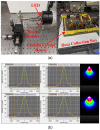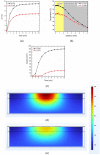Numerical Modeling and Simulation of Non-Invasive Acupuncture Therapy Utilizing Near-Infrared Light-Emitting Diode
- PMID: 37508864
- PMCID: PMC10376585
- DOI: 10.3390/bioengineering10070837
Numerical Modeling and Simulation of Non-Invasive Acupuncture Therapy Utilizing Near-Infrared Light-Emitting Diode
Abstract
Acupuncture is one of the most extensively used complementary and alternative medicine therapies worldwide. In this study, we explore the use of near-infrared light-emitting diodes (LEDs) to provide acupuncture-like physical stimulus to the skin tissue, but in a completely non-invasive way. A computational modeling framework has been developed to investigate the light-tissue interaction within a three-dimensional multi-layer model of skin tissue. Finite element-based analysis has been conducted, to obtain the spatiotemporal temperature distribution within the skin tissue, by solving Pennes' bioheat transfer equation, coupled with the Beer-Lambert law. The irradiation profile of the LED has been experimentally characterized and imposed in the numerical model. The experimental validation of the developed model has been conducted through comparing the numerical model predictions with those obtained experimentally on the agar phantom. The effects of the LED power, treatment duration, LED distance from the skin surface, and usage of multiple LEDs on the temperature distribution attained within the skin tissue have been systematically investigated, highlighting the safe operating power of the selected LEDs. The presented information about the spatiotemporal temperature distribution, and critical factors affecting it, would assist in better optimizing the desired thermal dosage, thereby enabling a safe and effective LED-based photothermal therapy.
Keywords: acupoints; acupuncture; bio-heat transfer; computational modeling; light-tissue interaction; photothermal effect; thermal therapy.
Conflict of interest statement
The authors declare no conflict of interest.
Figures












References
-
- Chow S.L., Bozkurt B., Baker W.L., Bleske B.E., Breathett K., Fonarow G.C., Greenberg B., Khazanie P., Leclerc J., Morris A.A. Complementary and Alternative Medicines in the Management of Heart Failure: A Scientific Statement From the American Heart Association. Circulation. 2023;147:e4–e30. doi: 10.1161/CIR.0000000000001110. - DOI - PubMed
-
- Esmail N. Complementary and Alternative Medicine. Fraser Institute; Vancouver, BC, Canada: 2017.
-
- Milenkovic J. Complementary and alternative medicine in European countries-legislative framework. Tradit. Med. Res. 2020;5:125. doi: 10.53388/TMR20190718125. - DOI
LinkOut - more resources
Full Text Sources

